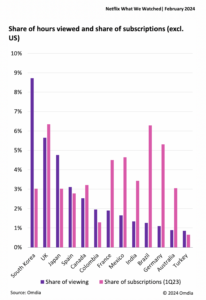
After more than 35 years of operation, TBI is closing its doors and our website will no longer be updated daily. Thank you for all of your support.
TBI Tech & Analysis: Underlining the value of Netflix’s non-English content

The Glory (Source: Netflix)
Omdia’s senior analyst Daoud Jackson delves into Netflix’s global viewership data and explores what it tells us about global consumption patterns.
Netflix is both a supplier and a producer of content at a global level, and its viewership data allows us to see where substantial asymmetries exist between where shows are produced and where they are consumed.
The US is the largest provider of both content and subscriptions. Though 57.7% of Netflix viewing from January to June 2023 was of US titles, just 28.9% of subscriptions – as of end Q1 2023 – were from the US.
This relationship is unsurprising but it is worth reminding ourselves that 60% of Netflix’s subscription count now comes from markets where English is not the primary language, and that Netflix represents an accessible source of American content, especially in markets such as Germany and Australia.
South Korea has rapidly become Netflix’s most important content export market. In the Jan-June 2023 period, 8.7% of Netflix’s total viewership came from South Korean shows, such as The Glory, and just 3% of the company’s subscriptions come from the peninsula.
In June 2023, Ted Sarandos underlined the broad appeal of Korean content by remarking that 60% of users had watched at least some Korean content.

[Click to expand]
Breaking it down
Comparing subscription numbers to viewing hours is not exactly comparing apples with apples: consumer behaviour and sharing varies from market to market.
Omdia research suggests that consumers in markets such as Brazil are much more likely to share their accounts. Therefore, a single subscriber is likely to have many more hours watched on their accounts in these markets than in one in markets where subscription sharing is not as common.
Nonetheless, it a safe assumption that much of the content watched in markets such as France and Germany on Netflix is from the US.
English-language viewing was less concentrated around top titles than viewing in other languages. The top 10 English-language titles accounted for 4.7% of all viewing on the platform.
In turn, the top 100 English-language franchises (grouping series, sequels, and spinoffs under a single name) accounted for just 16.5% of the total viewing on the platform. The fact that almost 85% of Netflix viewing does not come from the top 100 English franchises underlines the importance of Netflix’s back catalogue and non-English content.
Beyond English, Spanish saw the largest positive difference between titles and viewing hours: just 5.2% of the top 18,000 titles were originally in Spanish, but these accounted for 8.3% of viewing in this period.
The top 10 Spanish-language titles accounted for 2.0% of total viewing on the platform, propelled by Colombian dramas Fake Profile and The Marked Heart and Season 3 of La Reina del Sur.
Overall, the top 38 Spanish-language titles accounted for 50% of all viewing of Spanish-language titles in this period; meanwhile, the equivalent mark for English was the top 453, showing far less concentrated viewing of top titles.
The number of titles in languages such as Japanese is slightly higher than average because anime series are often split into subsections. Equivalent Spanish series are often undivided and constitute more than 50 episodes, pushing down the title count in comparison with English-language shows.
The excerpt above comes from Omdia’s ‘What We Watched: Analyzing The Long Tail of Netflix Viewing’ report, by Daoud Jackson, senior analyst, media and entertainment, which can be read in full here (with a subscription). Omdia and TBI are both part of Informa Tech.


